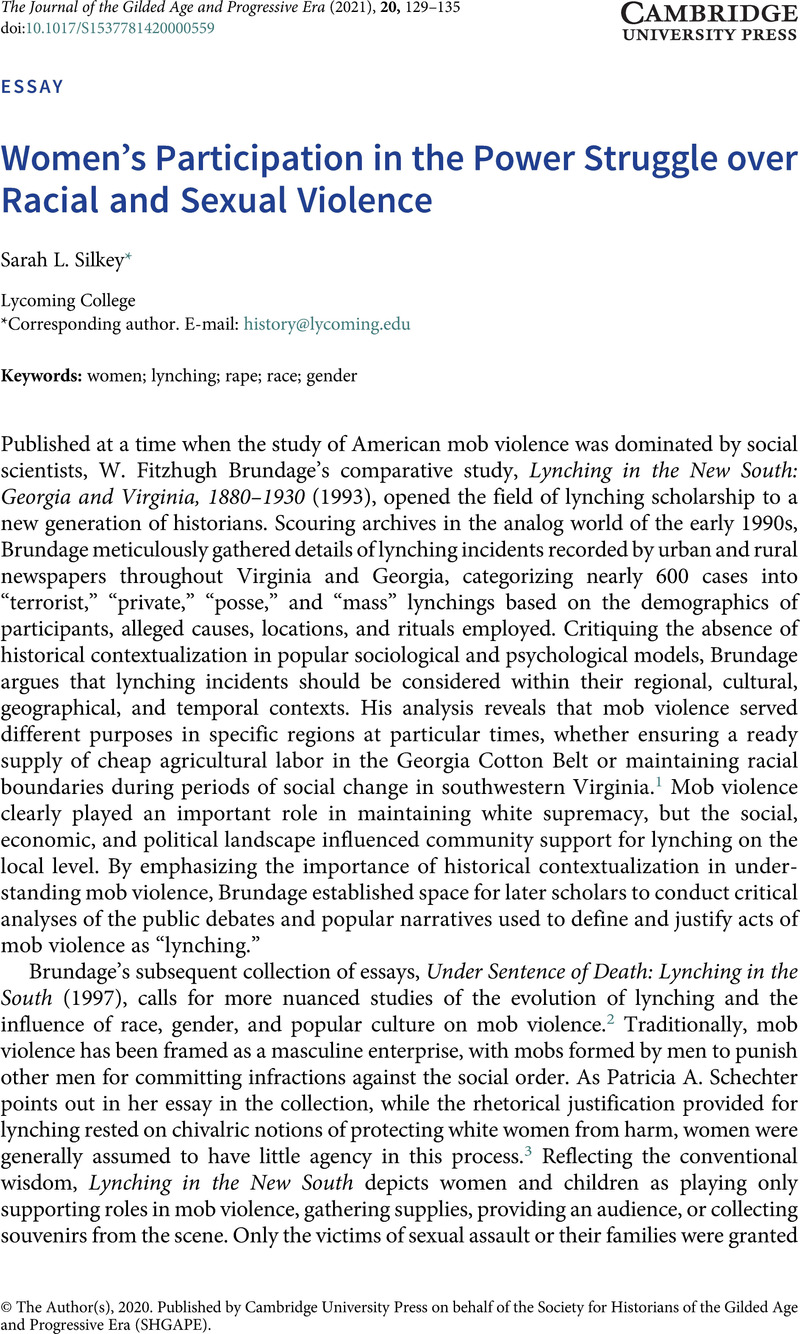No CrossRef data available.
Published online by Cambridge University Press: 01 December 2020

1 Brundage, W. Fitzhugh, Lynching in the New South: Georgia and Virginia, 1880–1930 (Urbana: University of Illinois Press, 1993), 18–19, 137–38, 145–46, 158–59.Google Scholar
2 Brundage, W. Fitzhugh, ed., Under Sentence of Death: Lynching in the South (Chapel Hill: University of North Carolina Press, 1997), 1–16.Google Scholar
3 Schechter, Patricia A, “Unsettled Business: Ida B. Wells against Lynching, or, How Antilynching Got Its Gender” in Under Sentence of Death, ed. Brundage , 292, 300–301.Google Scholar
4 Brundage, Lynching in the New South, 37–38, 41–42, 80–81.
5 For analysis of “black beast” mythology, see Williamson, Joel, The Crucible of Race: Black-White Relations in the American South since Emancipation (New York: Oxford University Press, 1984).Google Scholar
6 Hall, Jacquelyn Dowd, Revolt against Chivalry: Jesse Daniel Ames and the Women’s Campaign against Lynching (New York: Columbia University Press, 1979), 151.Google Scholar
7 Feimster, Crystal N, Southern Horrors: Women and the Politics of Rape and Lynching (Cambridge, MA: Harvard University Press, 2009), 5.Google Scholar
8 Feimster, Southern Horrors, 90.
9 “Made a Sensation: Mrs. Felton’s Advocacy of Lynching Attracts Much Attention—What She Said,” Topeka (Kansas) State Journal, Aug. 16, 1897, 2.
10 Feimster, Southern Horrors, 6.
11 Feimster, Southern Horrors, 91.
12 Feimster, Southern Horrors, 64–70, 85–86, 127.
13 Silkey, Sarah L, Black Woman Reformer: Ida B. Wells, Lynching, and Transatlantic Activism (Athens: University of Georgia Press, 2015), 115–22.Google Scholar
14 Feimster, Southern Horrors, 131–35, 187.
15 Feimster, Southern Horrors, 142–43, 146–47, 149–50, 155.
16 Gillin, Kate Côté, Shrill Hurrahs: Women, Gender, and Racial Violence in South Carolina, 1865–1900 (Columbia: University of South Carolina Press, 2013), 114–15, 120–21, 125.CrossRefGoogle Scholar
17 Wells, Ida B, “Southern Horrors: Lynch Law in All Its Phases” in Southern Horrors and Other Writings: The Anti-Lynching Campaign of Ida B. Wells, 1892-1900, ed. Royster, Jacqueline Jones (Boston: Bedford/St. Martin’s, 1997), 54–58.Google Scholar
18 Simmons, LaKisha Michelle, Crescent City Girls: The Lives of Young Black Women in Segregated New Orleans (Chapel Hill: University of North Carolina Press, 2015), 82.Google Scholar
19 Feimster, Southern Horrors, 175–77, 180, 185.
20 Waldrep, Christopher, The Many Faces of Judge Lynch: Extralegal Violence and Punishment in America (New York: Palgrave, 2002), 3–4.CrossRefGoogle Scholar
21 Feimster, Southern Horrors, 159–67, 180–84.
22 Feimster, Southern Horrors, 160.
23 Silkey, Black Woman Reformer, 18–29.
24 Feimster, Southern Horrors, 159–67, 180–84.
25 For example, see “Governor’s Remarkable Declaration,” Evening Telegraph and Star and Sheffield Daily Times, Aug. 13, 1897; “Lynching in America,” Sheffield Daily Telegraph, Aug. 14, 1897; “Life in America,” Belfast News-Letter, Aug. 14, 1897.
26 Martinez, Monica Muñoz, The Injustice Never Leaves You: Anti-Mexican Violence in Texas (Cambridge, MA: Harvard University Press, 2018), 48–50 Google Scholar; Gabriela González, Redeeming La Raza: Transborder Modernity, Race, Respectability, and Rights (New York: Oxford University Press, 2018), 19–27; William D. Carrigan and Clive Webb, Forgotten Dead: Mob Violence against Mexicans in the United States, 1848–1928 (New York: Oxford University Press, 2013), 118–22; Juan González and Joseph Torres, News for All the People: The Epic Story of Race and the American Media (London: Verso, 2011), 220–24.
27 Notable transnational and comparative studies include Angelina Snodgrass Godoy, Popular Injustice: Violence, Community, and Law in Latin America (Stanford, CA: Stanford University Press, 2006); Evans, Ivan Thomas, Cultures of Violence: Lynching and Racial Killing in South Africa and the American South (Manchester: Manchester University Press, 2009)CrossRefGoogle Scholar; Manfred Berg and Simon Wendt, eds., Globalizing Lynching History: Vigilantism and Extralegal Punishment from an International Perspective (New York: Palgrave Macmillan, 2011); Robert W. Thurston, Lynching: American Mob Murder in Global Perspective (Burlington, VT: Ashgate, 2011); William D. Carrigan and Christopher Waldrep, eds., Swift to Wrath: Lynching in Global Perspective (Charlottesville: University of Virginia Press, 2013); Michael J. Pfeifer, ed., Global Lynching and Collective Violence, 2 vols. (Urbana: University of Illinois Press, 2017); Gema Santamaría and David Carey Jr., eds., Violence and Crime in Latin America: Representations and Politics (Norman: University of Oklahoma Press, 2017).
28 Santamaría, Gema, “Legitimating Lynching: Public Opinion and Extralegal Violence in Mexico” in Violence and Crime in Latin America: Representations and Politics, eds. Santamaría, Gema and Carey, David Jr. (Norman: University of Oklahoma Press, 2017), 44–60.Google Scholar